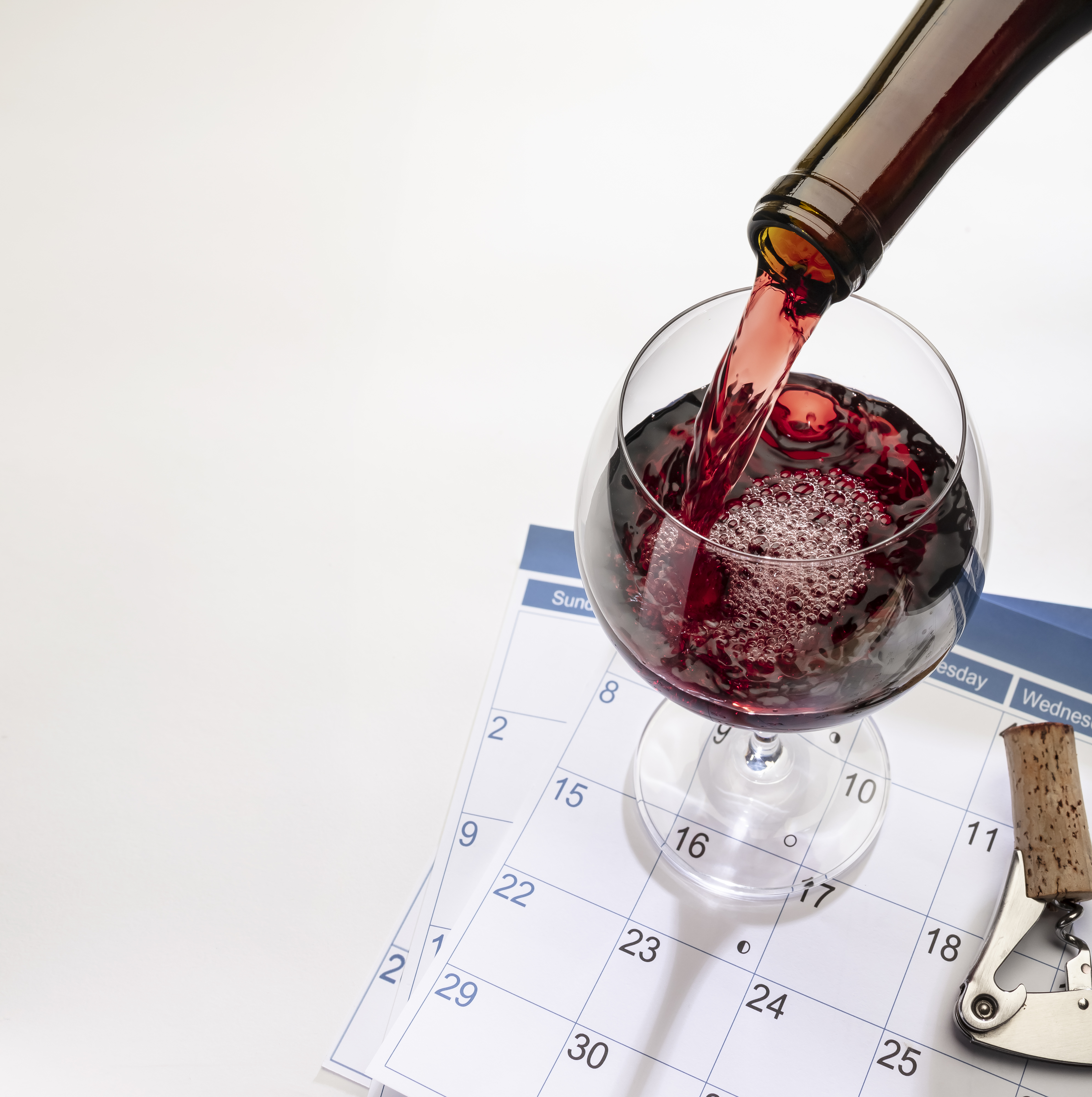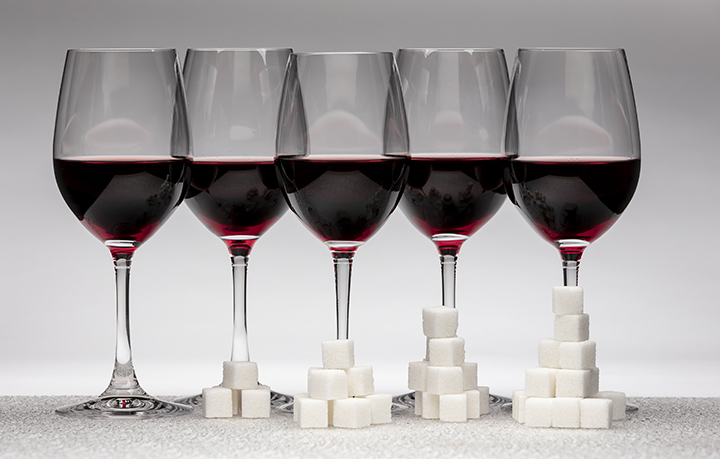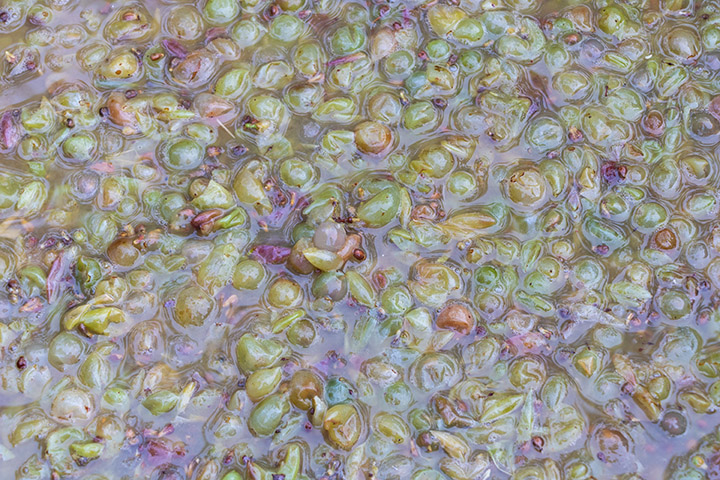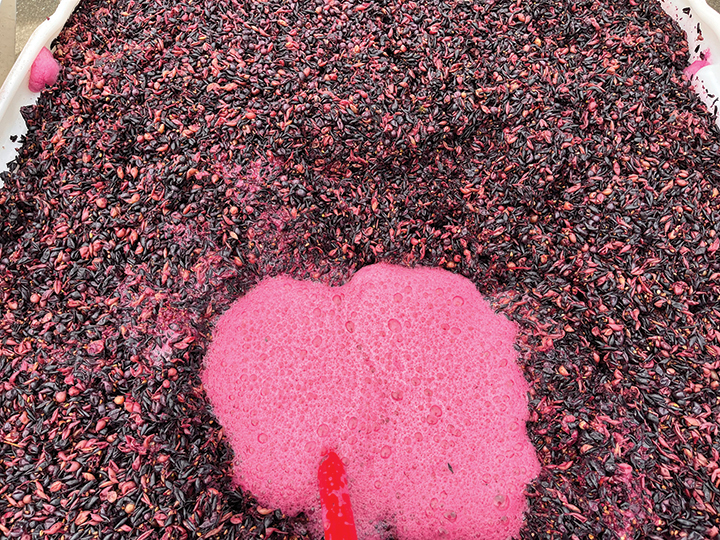Making Lemonade: Vineyard fixes for underwhelming grapes
As this issue hits mailboxes and newsstands, harvest 2021 is in full swing, or for many, just wrapping up here in the Northern Hemisphere. There’s no better feeling than walking through a tidy, harvested vineyard into a barn filled with topped up wine barrels and carboys. It’s the winemaker equivalent of being a CPA in late April. Crazy times will come again next year, but for now we can relax and take stock of the successes and failures we had in the 2021 vintage.
The purpose of this column is to identify flaws and deficits in a vintage of wine we grew ourselves, and then to discuss and detail cultural practices and tweaks to our farming to address those issues. Not all problems in wine can be fixed, especially for a small production/home vineyard sized operation. Many problems with a wine/vintage are endemic to the terroir and year in which they were created. Some home vineyards, to be blunt, have the wrong grapes in the wrong place.
I hear many of you, “But I buy my fruit from a vineyard.” Is there any use in further reading? Yes! Knowing viticultural tricks of the trade gives you expertise from which you can ask your grower to fine-tune your sections. In short, there is no downside to being vineyard-literate as a winemaker.
Here are the “Top Three Complaints” I hear from small-scale growers/winemakers and some pro tips and tricks to help:
“My wine is thin, green, or underripe.”
Causes/Solutions:
Low Brix: Picking fruit at low Brix (under 23 °Brix for red wine and under 22 °Brix for white to choose my own personal levels of ripeness I prefer to avoid) can make a wine that does not offer good color, fruit, extract, or length of finish. No one wants to pick their backyard vineyard at 20 °Brix, but if a hailstorm or the remnants of a tropical storm or hurricane are expected to flood or pelt the vineyard, you might not have much of a choice. Some solutions to help build a healthy vineyard that makes sweet fruit might include: Dropping some crop if it’s too heavy, to allow the remaining fruit to sweeten up quicker. Try to maintain a leaf:cluster ratio of between 12–15 leaves per cluster, and do expose the fruit to as much sunlight as is safe not to burn the skins. Expect heat spikes, as they almost always come near harvest, so don’t leave your clusters exposed and susceptible to sunburn. Another great strategy in a red wine vineyard is to change your winemaking style to match the fruit ripeness that vintage offers. In a perfect year where the fruit comes in between 23–25 °Brix, make red wine. If the weather wreaks havoc and the fruit is underripe, say 19–22 °Brix, make a skin-contact rosé. If a white wine vineyard harvests at low Brix, try your hand at making a pét-nat sparkling wine (see June-July 2021 issue for more on this style) if you have the courage to give it a try. Of course, even though the flavors will not be rich and dense, you can always add sugar to the must for a little more alcohol and mouthfeel. I suggest a 50/50 blend of white and brown sugars. Add slowly and as early after crush as possible, before ferment, to raise the Brix on reds to 24, and on whites to 23.
If the weather wreaks havoc and the fruit is underripe, say 19–22 °Brix, make a skin-contact rosé.
High acid, low pH: Similar difficult vintages that produce low sugar in the grapes will usually show high acidity and low pH. Because pH impacts mouthfeel so strongly, I tend to use it as a measure of acidity, and rarely measure total/titratable acidity (TA) unless I think knowing both pH and TA would be helpful. The flavor problems associated with low-pH/high-acid wines are unpalatable tartness and sourness, metallic flavor, loss of balance and often, a wine that is difficult to enjoy. I consider 3.2 or lower pH in red wine grapes to be low-pH/high-acid, and under 3.1 pH in whites. Low pH is definitely “fixable” in juice or must, using the addition of food-grade potassium bicarbonate. Adding this material at a rate of 3.5 grams/gallon (0.92 grams/liter) will reduce TA and raise pH by about 0.1, and it is not recommended to use more than 7 grams/gallon (1.8 grams/liter), or a 0.2 shift. That would take 3.2 pH to almost 3.5, as the pH rise will be slightly more than 0.2 using potassium bicarbonate. Of course, allowing the grapes to stay on the vine longer (if practicable), is always preferred to chemical intervention.
Lack of phenolic ripeness: Wines that lack phenolic ripeness taste much like an unripe strawberry that is white and crystalline in the middle, instead of a ripe, blood-red berry that is sweet and luscious throughout the flesh. Wine is not made delicious and balanced by causing the vines to suffer and shut down. You might be able to raise the Brix on your grapes by turning the water off and making them concentrate the sugars by dehydration/dimpling, but you might as well just add sugar to your must, as the grapes are not developing flavor/richness and color unless the vines are healthy enough to complete the ripening of the fruit through harvest. So as you consider your watering regime, summer/fall rainfall, balancing the vineyard, and choosing a harvest date, please consider that healthy vines hanging a healthy crop with working, green leaves is what brings in a harvest that balances flavor, Brix, and pH. Pro winemakers might add a bit of grape concentrate to must that lacks phenolic ripeness, and you can always check with a winemaking supply company to see if they have products that approximate Mega-Purple.
Poor weather/rain/lack of heat/degree day accumulation: As I mentioned at the beginning of this section, there are times when we must pull the trigger on winegrape harvest due to weather beyond our control. There are also years, but not many recently here in California, where the weather stays cloudy and cool in the summer, and the grapes do not achieve target ripeness. Winegrapes are usually grown between the 30th and 50th parallels of latitude, but we are starting to see that shift as global temperatures rise, and vines are now being planted in traditionally colder areas of Europe, Asia, and North America. Even though we would imagine that warmer temperatures might help our vineyards achieve better sugars, climate change also seems to be increasing the frequency and severity of summer and fall storms, so we need to take the good with the bad. Be patient, realize that a bit of rain doesn’t impact the vintage as much as some folks think, and if it looks like sunny weather will follow the rain, grizzled winemaking veterans usually know from experience that waiting a storm out, unless it’s a deluge, can still make for a good vintage. Be patient, but know when nature forces your hand.
Poor canopy management: Varietal winegrapes grown in shade taste vegetal and herbaceous. Fruit grown with at least 10% of ambient sunlight flecking the fruit (without burning it) is the key to producing rich, fruit flavors in the wine. Sunlight degrades the molecular structure of methoxypyrazine, the compound responsible for bell pepper flavors in red wine, and jalapeño/pasilla chili flavor in whites. With proper sun flecking on the fruit the pyrazines shift chemical bonds and become monoterpenes — a huge bonus for the flavors of all wines, showing white flower character in aromatic whites and high-toned berry character in reds. An open, airy canopy that still protects the fruit from sunburn in heat events, is what we shoot for. This canopy management style also decreases humidity, rot/mildew pressure, makes the fruit zone inhospitable to pests and critters, and will also make your sprays far more efficacious.
“My wine has flaws and bad flavors that I attribute to the vineyard.”
Causes/Solutions:
Mildew/rot: Sorting rot/mildew at harvest is vital to keep your wine from tasting musty and bacterial. I teach my pickers to recognize mildew, black rot, and Botrytis, and to cut it out of clusters before they are thrown in the bucket, and then sort again at the crusher. A cluster that is more than 2⁄3 affected is tossed on the vineyard floor under my direction. In subsequent years, up your spray game to keep the mildew and rot under control. If you can see mildew or rot, it’s likely too late for control in the current vintage. Visible fungus means the vineyard is already massively infected. The main causes for a mildew/rot infection are underpowered spray rigs (no penetration into the canopy), rank canopy with minimal management (open it up without burning the fruit), and inconsistent or lazy spray schedules. At or just under 5% mildew-affected fruit will impact the sensory elements of any wine. Sort it out and next year, farm clean!
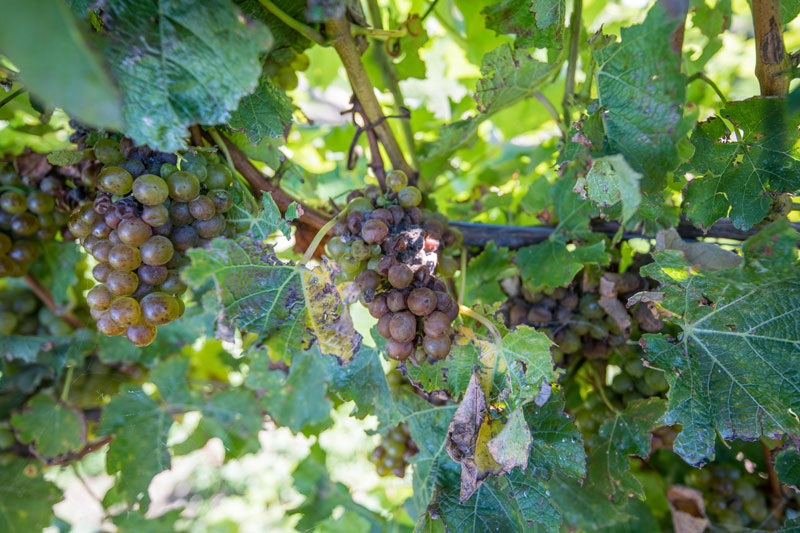
Insects in the ferment: Anyone else already shaking their fist at Japanese beetles? They have to be handpicked from the vines before harvest and removed/destroyed. A single beetle, like the Japanese, can cause off-flavors in a small-batch ferment. In California, we have a lot of earwigs or pincher bugs that like to climb in clusters to cool off in the hot harvest months. I have seen hundreds climbing to the top of red wine cold soaking after crush. Fortunately they don’t cause off-flavors that I have found, but we put a plastic shovel on top of the soaking grapes and the bugs all seem to climb on it like a safety boat, and then we remove them and dispose of the bugs before they die and sink to the bottom of the fermenter. Fruit flies are a winery issue, but are the most serious vector of Acetobacter, which causes volatile acidity and starts a wine on a slow and terrible road to turning into vinegar. Fruit fly traps, sticky tape, and other control measures should be strongly implemented to keep fruit flies well under control. If they are visible on barrel bungs or carboy stoppers, or worse, they are laying eggs there, you need to work harder on eliminating them year-round.
Shaded fruit: As described in the “poor canopy management” section previously, shaded fruit makes vegetal wine. Proper canopy management is often defined as always having no more than ONE LEAF between the sunlight and the fruit. I like to pull leaves around and below the clusters so that early morning and late afternoon sunshine can bathe the clusters, but they are protected with a “sombrero leaf” above during the hottest parts of the day, say 10 a.m.–4 p.m. If your fruit still burns in this system, leave a few more leaves, but do thin all the leaves in the middle of the fruiting zone that do not shade the clusters — these will just produce water vapor/humidity that increases mildew/rot pressure and attracts pests by giving them a shaded, protected home. If the notes on your homegrown wine include references like “canned olive,” “bell pepper,” “green,” or if the wine lacks color, richness, or persistent fruit character, a little more sun on the fruit may be just what you need. Do some experiments each year with different rows/vines and see how much leaf-pulling in the fruit zone can be accomplished without burning the crop.
Bird pecked/damaged fruit: In short, you should be netting your vines at or right before fruit softening/veraison. Red wine grapes get more than twice the attention of birds than their white counterparts. Red means “go” to a bird! Buying bird net that drapes all the way over the vine row is preferable, but I have seen success in fruit zone netting — using a 2–3 ft. (0.6–0.9 m) strip that is clipped on the canopy and only excludes the birds from the fruit area. But I do prefer netting the whole vine, and folding/gathering the net at the bottom and securing it so birds and squirrels/skunks, etc., can’t climb inside the vine. Some birds are learning to hang off the net and peck at the fruit, so if there’s a little billowing space between the fruit and the net, that’s even better! Taking the nets off for harvest is a wonderful feeling, seeing pristine clusters with nary a berry pecked. Pet cats and even dogs can reduce bird and pest pressure in a backyard vineyard, as can propane cannons and shotguns, but those are generally frowned upon by residential and even suburban neighbors. In the end, if you are forced to make wine with bird or insect damaged fruit, double the amount of SO2 you use at the crusher, up to about 100 ppm for highly damaged fruit to sterilize the fruit and knock out some volatile acidity that has likely already developed.
“My wine is soft, flabby, and overripe.”
Causes/Solutions:
Waiting too long to pick: How luxurious it must be to get fruit as ripe as you want it every year! Many home winemakers in places like California, Arizona, Oregon, Washington, and other sunny areas have the benefit of allowing ripeness to not only be achieved but overachieved. We can all imagine the tendency to love big, rich, ripe, high-octane wines that approximate a high-scoring wine from Robert Parker or in Wine Spectator. If 25 °Brix last season made great wine, maybe 27 °Brix will make a better wine this year. And why not 30 °Brix if the vines will allow it? It is not my job to tell you your business stylistically in crafting wines. But if the wines you make start tasting like raisins or Port when they are young and the wines are lacking structure, balance, or verve, and these are flavors/styles that you don’t appreciate, you may want to pick just a bit earlier each year until you achieve the balance and flavors you aim for in a wine. I have made very good wines from fruit at almost 30 °Brix in a crazy Santa Barbara heat spike, but I did water the must back to 25 °Brix and added acid to get the pH at 3.5 after cold soak, when I pitched the yeast.
Lack of proper field ripeness testing: If you can’t accurately measure field ripeness before harvesting, it is nearly impossible to be able to have the foresight and data tools to make consistently ripe, balanced, delicious wines. Doing a field sample without randomizing protocol will almost always produce results that show 1–2 °Brix higher results than what you will see after picking, crushing, and testing. Some folks learn this the hard way and then try to go the other way and test fruit that they have chosen because it’s not as ripe, and then they end up with overripe fruit they weren’t expecting. This is why I always test my own fruit from vineyards I buy from using a protocol that has proven amazingly accurate. Choose an odd, prime number besides 1. I usually choose 3, 5, or 7 for small vineyards, and if you only have a dozen vines, 3 might be the best. Go three vines in, then three clusters in, take a berry from the shoulder, middle, and bottom of that cluster and put it in a Ziplock bag or a small bucket. Then switch rows by turning around (as long as it’s the same varietal or you plan to field blend at the crusher), go three vines down, three clusters in, grab the berries top, middle, and bottom, and keep going. Try to choose a representative sample from the entire vineyard, the more vines, the bigger the sample. This prevents you from using your natural gift of finding the ripest fruit. The randomness of the sample should provide accurate ripeness models. Make sure to test and calibrate your tools for measuring Brix, pH, and, if you’re an overachiever, TA. Inaccurate tests are a waste of time and labor, and can negatively impact the target flavor profile of your homegrown wine.
Poor sorting at harvest/at the crusher: You spent a whole year growing that crop of grapes, let’s put in enough work at the harvest vessels, crusher/sorter table to improve the quality of the resulting wine. Make sure every picker at harvest knows what a good and bad cluster looks like, and show them how to snip away little raisins, rot, mildew, or pest/bird damage. Make sure they know if there might be Japanese beetles or other pests on the fruit, and inform them to pick them off and be careful that one doesn’t get in their bucket. I do not personally believe in berry-by-berry sorting, as I believe the oxidation of the juice negates any positive impact, but sorting cluster by cluster makes a lot of sense in a small-production winery setting. This can also be done by just lifting individual clusters into the crusher as you are evaluating/clipping out problem parts, etc. Raisins and heavily dimpled berries over 5–10% will certainly give the wine a Port-like, raisiny flavor, and the sugars will spike in the fermenter as much as 3–4 °Brix as the sugar spreads from the raisins to the juice.
Too much leaf pulling/sun on fruit zone: Sunburned fruit means you likely pulled too many leaves from your fruiting zone before a heat event, your vines are too young to protect the fruit with a full canopy, or a heat event surprised you and burned the fruit with a level of leaf pulling that is usually dialed in for your region. Raisins and dimpling can usually be cut out or left in small amounts in the wine for added sugar, but can produce Port-like aromas and flavors some would consider a fault. If the fruit is burned into tiny brown or black grapes, in other words, “to a crisp,” I suggest rubbing your picking snips along the affected areas and the burnt little buddies will fall off the rachis (stem) quite easily.



